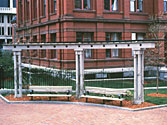 When welded items are galvanized, both the cleanliness of the weld area after welding and the metallic composition of the weld itself affect galvanizing quality and appearance at the weld.
When welded items are galvanized, both the cleanliness of the weld area after welding and the metallic composition of the weld itself affect galvanizing quality and appearance at the weld.
The specifics of welding techniques can best be obtained from the American Welding Society or your welding equipment supplier, but several welding processes and techniques have been found to be most satisfactory for items to be galvanized. These are:
- 1. In welding, an uncoated electrode should be used wherever possible to prevent flux deposits.
- If a coated electrode is used, all welding flux residues must be removed by wire brushing, flame cleaning, chipping, grinding, pneumatic needle gun, or abrasive blast cleaning. Welding flux residues are chemically inert in the normal pickling solutions used by galvanizers; their existence will produce rough and incomplete zinc coverage. Flux residue removal is normally the fabricator’s responsibility unless other arrangements have been made.
- A welding process such as metal-inert gas (MIG), tungsten-inert gas (TIG) or C02 shielded arc is recommended when possible since they produce essentially no slag.
- In the case of heavy weldments, a submerged arc method is recommended.
- If none of these are available, select a coated rod specifically designed for “selfslagging”, as recommended by welding equipment suppliers.
- Choose a welding rod providing a deposited weld composition as close as possible to the parent metal. This will help prevent differential acid attack between the weld area and the parent metal during acid cleaning.
- Welding rods high in silicon may cause excessively thick and/or darkened coatings to form in the welded area.
Materials which have been galvanized may be welded easily and satisfactorily by all common welding techniques. Additional information can be found in Welding Zinc-Coated Steel.*
